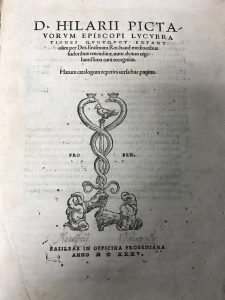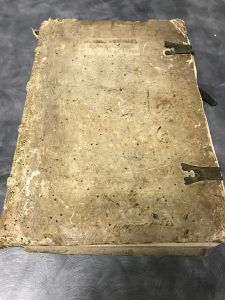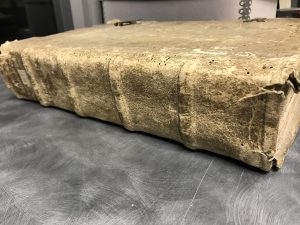Background
Donated by Dr. Leslie Poste in 1980, D. Hilarii Pictauorum is the second oldest book in Milne Library’s Special Collections at SUNY Geneseo. Published in Basel, Switzerland in 1535, this book is categorized at Milne Library as a religious text related to early Christian literature, criticisms, and “doctors of the church.” The translation for this title is, loosely, Hilary of Poitiers.
This book was written by Saint Hilary, Bishop of Poitiers, long before it was published in 1535. In fact, the actual person(s) who compiled this text for print are unidentified anywhere in the text. While we know far less about the origins of this book than that of Sicuti Anitquarum Lectionum, we can draw the same general conclusion that the main motivation Dr. Poste likely had in donating this text to Milne Library likely had little to do with the actual specific content, and more so with the craft and uniqueness of a book published around 480 years ago. Located on the River Rhine, Basel is a city in northwestern Switzerland. Around the time of this book’s publication, Basel had joined the Swiss Confederation, and in 1529, just a few years prior to the publication of D. Hilarii, adopted Protestantism as its national religion. This is an interesting note when considering the fact that this book is a Catholic text, and could indicate the city’s engagement in a complex theological conversation during this time in its history.
The title page of D. Hilarii shows an illustration of two hands holding a rod wrapped by two snakes looming over a small bird that sits atop the rod (Fig. 1). The meaning of this symbol is unrecognizable to me, so I can’t confidently comment any further on its meaning.

While an antiquarian bibliophile may be able to access this book online or even through other libraries, the copy given by Dr. Poste to Milne Library has its own unique qualities and characteristics that make it a worthwhile bibliographic specimen. Continue navigating this page to learn about the features specific to Milne Library’s copy of D. Hilarii Pictauorum!
Binding
Unlike Sicuti Antiquarum Lectionum, there is a good chance that the binding on D. Hilarii Pictauorum is, indeed original to its 1535 publication. While this may seem quite unlikely, given its age, as you may have learned through the additional bibliographic aspects of this site, the books made in the hand-press era were far more carefully made, and therefore much sturdier, than their mass-produced, modern counterparts. The binding on this copy is quite well done, and speaks to the antiquarian beauty of 16th century printing. Note its cover, spine, and pages (Fig. 2, Fig. 3, Fig. 4, respectively). While any decoration added to the front cover has long since faded, its integrity is still impressively intact, though riddled with bookworm trails. Its spine is also in great shape, showing little to no signs of unbinding anytime soon. Also note the clasps attached to the outer edge of the front and back covers; while they are no longer of any use, their presence follows the tradition of post-medieval binding practices. For more information on clasps, visit the page titled The Page – Characteristics and explore the interactive guide to 16th century books.



Watermarks
Interact with this Juxtapose JS image by sliding the dividing white line from left to right to reveal the hidden image of the watermark! Note that it is in the center of its page, indicating that this book is in a folio format (its larger sheet was only folded once to create the signature).
All photos by Amanda Wentworth.